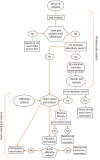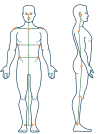Technological advancements in the analysis of human motion and posture management through digital devices
- PMID: 34354935
- PMCID: PMC8316840
- DOI: 10.5312/wjo.v12.i7.467
Technological advancements in the analysis of human motion and posture management through digital devices
Abstract
Technological development of motion and posture analyses is rapidly progressing, especially in rehabilitation settings and sport biomechanics. Consequently, clear discrimination among different measurement systems is required to diversify their use as needed. This review aims to resume the currently used motion and posture analysis systems, clarify and suggest the appropriate approaches suitable for specific cases or contexts. The currently gold standard systems of motion analysis, widely used in clinical settings, present several limitations related to marker placement or long procedure time. Fully automated and markerless systems are overcoming these drawbacks for conducting biomechanical studies, especially outside laboratories. Similarly, new posture analysis techniques are emerging, often driven by the need for fast and non-invasive methods to obtain high-precision results. These new technologies have also become effective for children or adolescents with non-specific back pain and postural insufficiencies. The evolutions of these methods aim to standardize measurements and provide manageable tools in clinical practice for the early diagnosis of musculoskeletal pathologies and to monitor daily improvements of each patient. Herein, these devices and their uses are described, providing researchers, clinicians, orthopedics, physical therapists, and sports coaches an effective guide to use new technologies in their practice as instruments of diagnosis, therapy, and prevention.
Keywords: Gait analysis; Inertial measurement unit; Motion capture; Posture; Rasterstereography; Wearable devices.
©The Author(s) 2021. Published by Baishideng Publishing Group Inc. All rights reserved.
Conflict of interest statement
Conflict-of-interest statement: All other authors have no competing interests to declare.
Figures





References
-
- Cimolin V, Galli M. Summary measures for clinical gait analysis: a literature review. Gait Posture . 2014;39:1005–1010. - PubMed
-
- Wren TAL, Tucker CA, Rethlefsen SA, Gorton GE 3rd, Õunpuu S. Clinical efficacy of instrumented gait analysis: Systematic review 2020 update. Gait Posture . 2020;80:274–279. - PubMed
-
- Ford KR, Myer GD, Toms HE, Hewett TE. Gender differences in the kinematics of unanticipated cutting in young athletes. Med Sci Sports Exerc . 2005;37:124–129. - PubMed
-
- Sjödahl C, Jarnlo GB, Söderberg B, Persson BM. Kinematic and kinetic gait analysis in the sagittal plane of trans-femoral amputees before and after special gait re-education. Prosthet Orthot Int . 2002;26:101–112. - PubMed
Publication types
LinkOut - more resources
Full Text Sources

